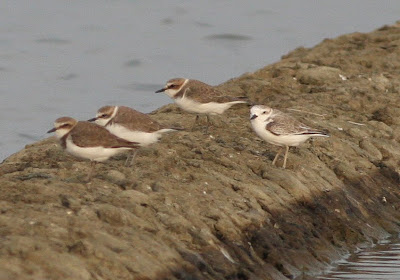After our unforgettable raptorama at Khao Dinsor, we made our way back north to Bangkok, via Laem Phak Bia (partway between the two) - well-known as a globally important area for wintering waders, with one species in particular recieving justly special attention.
Malaysian Plover
A vague plan to visit the area towards the end of our stay in the country was looking less and less likely to come off, and so Neil and Eunice's offer to make an overnight stop in the area en route was a godsend to say the very least.
Gull-billed Tern
Our target - the critically-endangered Spoon-billed Sandpiper, a beautiful and slightly absurd little shorebird, with the odds of survival sadly and increasingly stacked against it. The area - a vast expanse of saltpans just inland from the gulf coast, completely innocuous to the untrained eye, and with pretty much zero protection from development.
Eastern Black-tailed Godwits
Red-necked Stint
Again with our friend's invaluable local knowledge, we checked into a peachy little seaside resort (complete with a shady pool five paces from the ocean), which turned out to be less than a couple of kilometres from one of the key areas, known as the abandoned buildings.
Long-toed Stint
Marsh Sandpipers
We were resolved to the fact that our chances of connecting with the glittering prize were somewhat lessened by our circumstances; firstly, we had no 'scope - a near-essential piece of kit in such conditions - and secondly, it was still very early in the season. The peak period for both SBS and many other waders was still many weeks away, and we were likely to encounter only a fraction of the wintering hordes.
And so it was with a healthy dose of realism that a visit to the area in the evening - somewhat of a recon mission for the following morning - was encouragingly productive. Plenty of birds, of plenty of species - including an unexpected bonus in the shape of a very smart Malaysian Plover amongst a gang of Kentish (nice work Neil) made for a very entertaining session, and a busy party of Red-necked Phalaropes were equally welcome.
Great Knot
The site is both easy and frustrating to watch: it can only be birded from the track (most sensibly from a 4x4, for the terrain and for cover), and to have good (especially 'scope-less) views of the birds, they need to be both close to the track and on the right side of the sun. If either is lacking, you're effectively screwed; but if both happen to work out, the birding is wonderfully sedate and the birds are perfectly lit (especially early morning and late evening) .
Red-wattled Lapwing
White-throated Kingfisher
An additional obstacle is the landscape - the saltpans are spirit-level flat in all directions, and hence, the birds are very easily spooked. A careless movement from us (or even the gentle clunk of a car door), or the routes taken by site the random sprinkling of site workers, can spell an aborted mission at any given time.
Moth sp. in the mangroves (the size of an adult human hand....)
In truth, it wasn't such a huge disappointment to fail in finding an SBS amongst its commoner brethren during the evening, especially knowing our hand was hardly the strongest; we retired back to our base (via a Indian Nightjar calling nearby) having enjoyed the session immensely. The birding was excellent, and tomorrow was another day.
(part two to follow)














